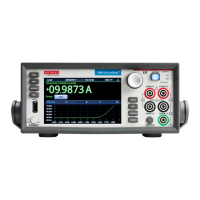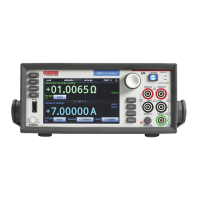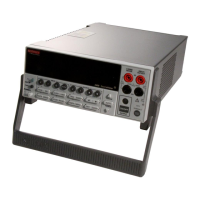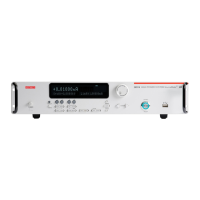2: General operation Model 2461 Interactive SourceMeter® Instrument
2-90 2461-901-01 A/November 2015
Use 4-wire connections when you are concerned about voltage drops because of lead or contact
resistance that could affect measurement accuracy. This can occur on low impedance devices when
you are sourcing or measuring voltage, especially in semiconductor device testing. For example,
when testing low impedance devices (less than 100 Ω), usually a higher current is sourced and small
voltages are measured.
Sourcing current and measuring voltage drops in a 4-wire configuration is used when measuring
resistivity of a material using a 4-point collinear probe.
It is sometimes necessary to use a 4-wire configuration when sourcing small voltages (less than 1 V)
and measuring current. This is true when performing I-V tests on semiconductor devices such as
diodes.
When you source or measure voltage in a low-impedance test circuit, there can be errors because of
lead resistance. Use 4-wire remote sensing to eliminate these errors. If you use 4-wire remote
sensing when you source voltage, the programmed voltage is delivered to the DUT. If you use 4-wire
remote sensing when you measure voltage, only the voltage drop across the DUT is measured.
The maximum voltage drop between the force and sense leads is 5 V.
When the output is off, the remote sense lines are disconnected and 4-wire sensing is disabled.
When the output is off, the instrument uses 2-wire sense, regardless of the sense setting. When the
output is on, the selected sense setting is used.
You can use 2-wire, or local sensing, measurement techniques for the following source-measure
conditions:
• Sourcing and measuring low current.
• Sourcing and measuring voltage in high impedance (more than 1 kΩ) test circuits.
• Measure-only operation (voltage or current).
When you use 2-wire sensing, voltage is sensed at the output connectors.
You should only use 2-wire connections if the error contributed by test-lead IR drop is acceptable.
Two-wire local sense connections
Two-wire connections are shown in the following figures.
If your application results in impedances above 1 GΩ, you may also need to use guarding. This
prevents leakage current from affecting measurement accuracy. For information, see Guarding (on
page 4-15).
To use 2-wire connections, you must set the sense mode of the instrument to 2-wire, as described in
the following topics.

